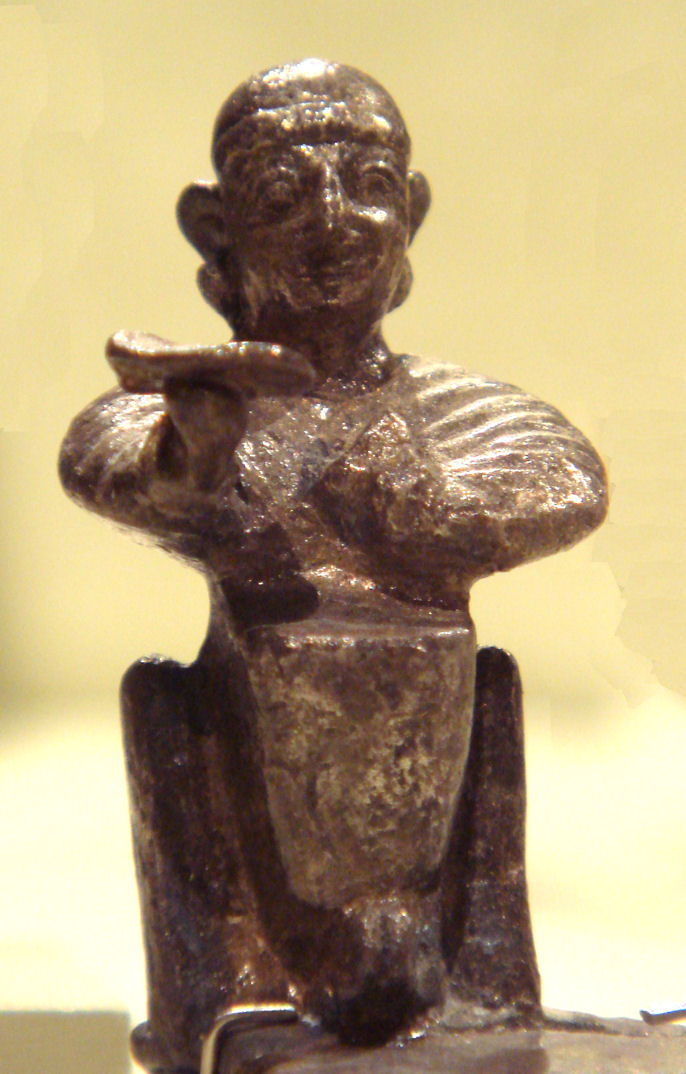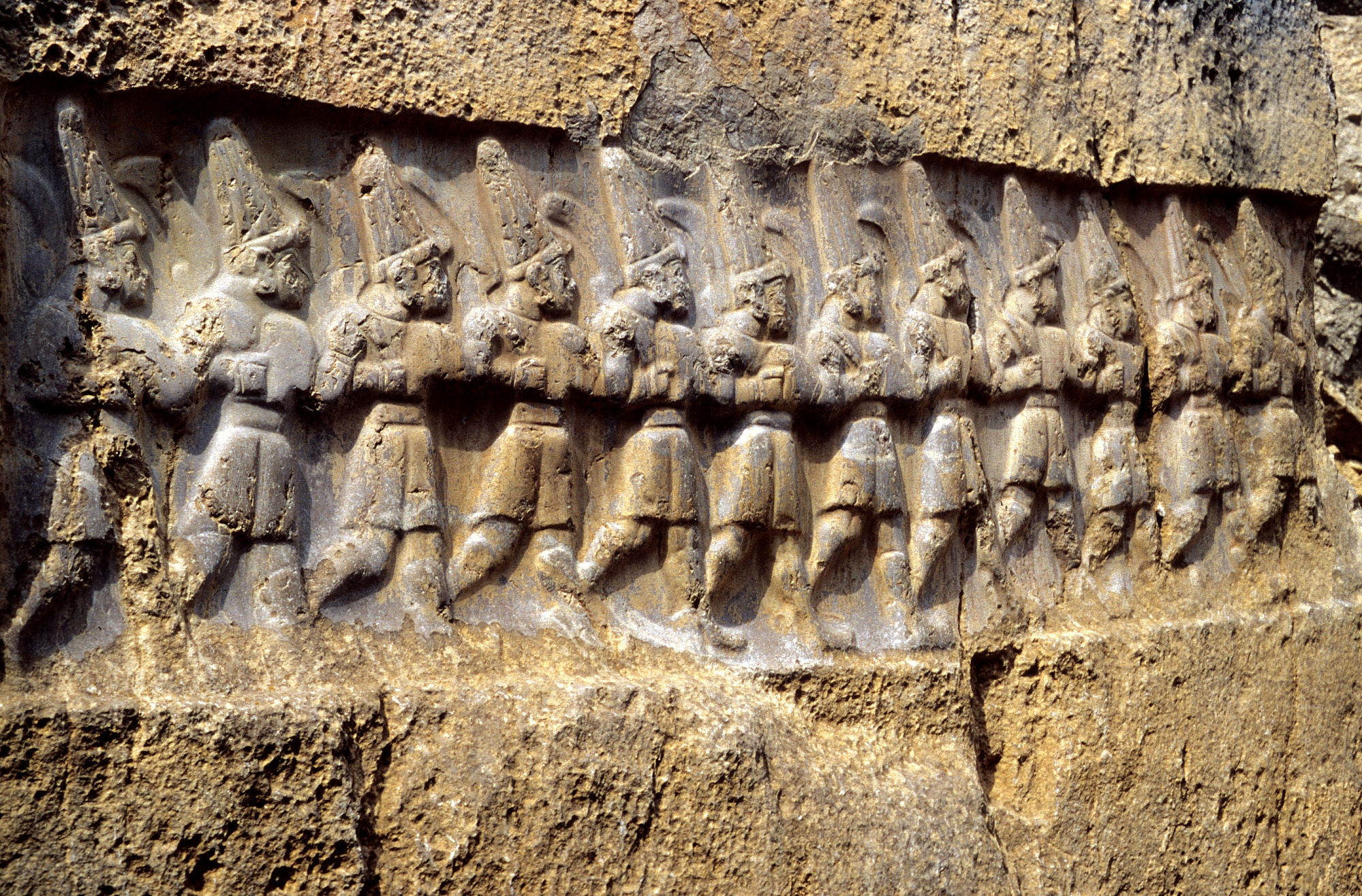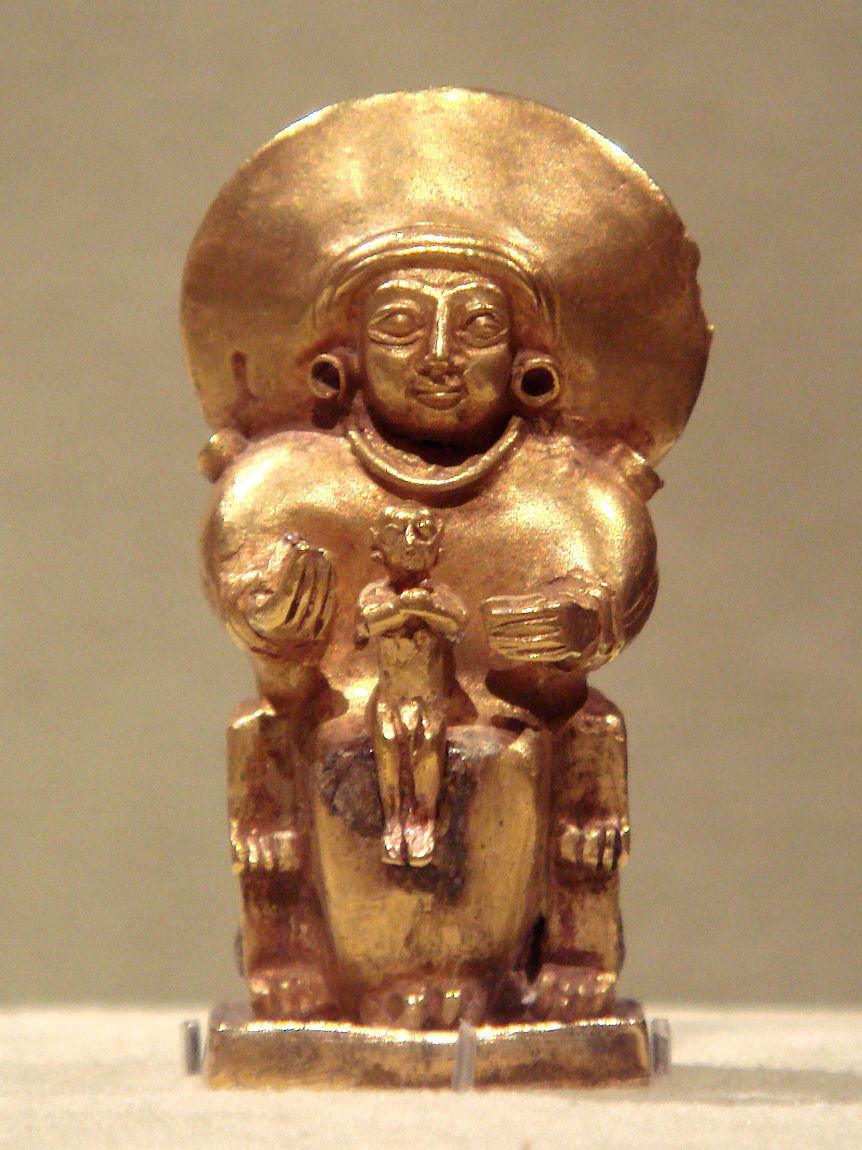|
Mezulla
Mezulla or Mezzulla was a minor Hittite goddess. She and her daughter ZintuáļŦi were closely associated with the Sun goddess of Arinna; together they formed a triple deity. Mezulla had only local importance and is not mentioned in the oath lists of Hittite interstate treaties. Family Mezulla was the daughter of the Sun goddess of Arinna and the weather god TaráļŦunna. Her daughter ZintuáļŦi was a goddess who had no special role. From the 13th century BC onwards, the corn god Telipinu, the Weather god of Zippalanda and the Weather god of Nerik are attested as her brothers. Role Like her mother, Mezulla was of Hattian origin and she was also known as Tappinu ( Hattian: "her daughter"). As the daughter of the two chief Hittite deities, she could be called upon to act as an intermediary with either of them, especially their mother. She also aided military campaigns. Mezulla had a temple in the holy city of Arinna, which was the second most important in the city after that of h ... [...More Info...] [...Related Items...] OR: [Wikipedia] [Google] [Baidu] |
Hittite Mythology
Hittite mythology and Hittite religion were the religious beliefs and practices of the Hittites, who created an empire centered in Anatolia from . Most of the narratives embodying Hittite mythology are lost, and the elements that would give a balanced view of Hittite religion are lacking among the tablets recovered at the Hittite capital Hattusa and other Hittite sites. Thus, "there are no canonical scriptures, no theological disquisitions or discourses, no aids to private devotion". Some religious documents formed part of the corpus with which young scribes were trained, and have survived, most of them dating from the last several decades before the final burning of the sites. The scribes in the royal administration, some of whose archives survive, were a bureaucracy, organizing and maintaining royal responsibilities in areas that would be considered part of religion today: temple organization, cultic administration, reports of diviners, make up the main body of surviving te ... [...More Info...] [...Related Items...] OR: [Wikipedia] [Google] [Baidu] |
TaráļŦunna
TaráļŦunna or TaráļŦuna/i was the Hittite weather god. He was also referred to as the "Weather god of Heaven" or the "Lord of the Land of Hatti". Name TaráļŦunna is a cognate of the Hittite verb ''taráļŦu-zi'', "to prevail, conquer, be powerful, be able, defeat"; from the Proto-Anatolian weather god ''*TáđáļŦu-ent-,'' "conquering"; ultimately from PIE ''*terhâ-'', "to cross over, pass through, overcome". The same name was used in almost all Anatolian languages: Luwian '' TaráļŦunz-''; Carian ''TrquÎī-''; Milyan ''TrqqÃąt-'', and Lycian: ''Trqqas'' (A), ''Trqqiz'' (B). Norbert Oettinger has argued that the functions of the Anatolian weather god ultimately come from the Proto-Indo-European god Perkwunos, but that they did not preserve the old name to coin instead the new epithet ''TáđáļŦu-ent-'' ("conquering"), which sounded close to the name of the Hattian Storm-god ''Taru''. Role As weather god, TaráļŦunna was responsible for the various manifestations of ... [...More Info...] [...Related Items...] OR: [Wikipedia] [Google] [Baidu] |
Hittite Deities
Hittite mythology and Hittite religion were the religious beliefs and practices of the Hittites, who created an empire centered in Anatolia from . Most of the narratives embodying Hittite mythology are lost, and the elements that would give a balanced view of Hittite religion are lacking among the tablets recovered at the Hittite capital Hattusa and other Hittite sites. Thus, "there are no canonical scriptures, no theological disquisitions or discourses, no aids to private devotion". Some religious documents formed part of the corpus with which young scribes were trained, and have survived, most of them dating from the last several decades before the final burning of the sites. The scribes in the royal administration, some of whose archives survive, were a bureaucracy, organizing and maintaining royal responsibilities in areas that would be considered part of religion today: temple organization, cultic administration, reports of diviners, make up the main body of surviving te ... [...More Info...] [...Related Items...] OR: [Wikipedia] [Google] [Baidu] |
Sun Goddess Of Arinna
The Sun goddess of Arinna, also sometimes identified as Arinniti or as Wuru(n)ÅĄemu, is the chief Goddess of Hittite mythology. Her companion is the weather god TaráļŦunna. She protected the Hittite kingdom and was called the "Queen of all lands." Her cult centre was the sacred city of Arinna. In addition to the Sun goddess of Arinna, the Hittites also worshipped the Sun goddess of the Earth and the Sun god of Heaven, while the Luwians originally worshipped the old Proto-Indo-European Sun god Tiwaz. It appears that in the northern cultural sphere of the early Hittites, there was no male solar deity. Distinguishing the various solar deities in the texts is difficult since most are simply written with the Sumerogram dUTU (Solar deity). As a result, the interpretation of the solar deities remains a subject of debate. Family and myths The Sun goddess of Arinna and the weather god TaráļŦunna formed a pair and together they occupied the highest position in the Hittite state's pa ... [...More Info...] [...Related Items...] OR: [Wikipedia] [Google] [Baidu] |
Triple Deity
A triple deity is a deity with three apparent forms that function as a singular whole. Such deities may sometimes be referred to as threefold, tripled, triplicate, tripartite, triune, triadic, or as a trinity. The number three has a long history of mythical associations and triple deities are common throughout world mythology. Carl Jung considered the arrangement of deities into triplets an archetype in the history of religion. In classical religious traditions, three separate beings may represent either a triad who typically appear as a group (the Greek Moirai, Charites, and Erinyes; the Norse Norns; or the Irish MorrÃgan), or a single deity notable for having three aspects (Greek Hecate, Roman Diana).Virgil addresses Hecate as ''tergemina Hecate, tria virginis, ora Dianae'' (''Aeneid'', 4.511). Trinitarian Christianity instead recognizes three " divine persons" in God the Father, the Son, and the Holy Spirit, which are usually distinguished from the idea of independ ... [...More Info...] [...Related Items...] OR: [Wikipedia] [Google] [Baidu] |
Telipinu (god)
Telipinu (; Hattic: ''Talipinu'' or ''Talapinu'', "Exalted Son")Beckman, Gary. "Telipinu" in ''Reallexicon der Assyriologie und Vorderasiatischen ArchÃĪologie'', Vol. 13. 2012 was a Hittite god who most likely served as a patron of farming, though he has also been suggested to have been a storm god or an embodiment of crops. He was a son of the weather god TaráļŦunna ( Taru) and the solar goddess Arinniti in the system of their mythology. His wife was the goddess áļŠatepuna, though he was also paired with and KataáļŦáļŦa at various cultic centres. Telipinu was honored every nine years with an extravagant festival in the autumn at áļŠanáļŦana and KaÅĄáļŦa, wherein 1000 sheep and 50 oxen were sacrificed and the symbol of the god, an oak tree, was replanted. He was also invoked formulaically in a daily prayer for King MurÅĄili II during the latter's reign. An ancient Hittite myth about Telipinu, the ''Telipinu Myth'', describes how his disappearance causes all fertility to fa ... [...More Info...] [...Related Items...] OR: [Wikipedia] [Google] [Baidu] |
Weather God Of Zippalanda
The Weather god of Zippalanda was a Hittite weather god, who was worshipped in the Hittite city of Zippalanda. The weather god of Zippalanda had several names, such as Ziplantil, WaÅĄezzili,Piotr Taracha: ''Religions of Second Millennium Anatolia''. Wiesbaden 2009, p. 55. WaÅĄezzil and WaÅĄezzaÅĄu. Role In ancient Anatolia, weather gods were the rulers of the sky and the mountains.Volkert Haas, Heidemarie Koch: ''Religionen des alten Orients: Hethiter und Iran''. GÃķttingen 2011, p. 228. They cast down thunder, lightning, clouds, rain and storms. The weather god of Zippalanda was also worshipped as a sender of rain. He was also worshipped as a fertility deity. Additionally, WaÅĄezzili was referred to as a "lion" among the gods and therefore as a divine hero. Family In the official state pantheon of the Hittites, the Weather god of Zippalanda Wasezzili was regarded as the son of TaráļŦunna, the 'Weather god of áļŠatti', and the Sun goddess of Arinna. As the son of the Sun god ... [...More Info...] [...Related Items...] OR: [Wikipedia] [Google] [Baidu] |
Weather God Of Nerik
The Weather god of Nerik is a Hittite weather god, who was mainly worshipped in the Hittite city of Nerik, whose cult was relocated to KaÅĄtama and TakupÅĄa for two hundred years after the Hittites lost Nerik to the Kaskians. He was also referred to as Nerak or Nerikkil. In ancient Anatolia Anatolia (), also known as Asia Minor, is a peninsula in West Asia that makes up the majority of the land area of Turkey. It is the westernmost protrusion of Asia and is geographically bounded by the Mediterranean Sea to the south, the Aegean ..., weather gods were the rulers of the sky and the mountains. They cast down the thunder, lightning, clouds, rain and storms.Volkert Haas, Heidemarie Koch: ''Religionen des alten Orients: Hethiter und Iran''. GÃķttingen 2011, p. 228. The weather god of Nerik was also worshipped as a sender of rain, and as a fertility deity. In the official Hittite state pantheon, the Weather god of Nerik was considered the son of the Weather god of áļŠatti and ... [...More Info...] [...Related Items...] OR: [Wikipedia] [Google] [Baidu] |
Hattian Mythology
Hattian may refer to: * someone or something related to Hattians, an ancient people of Anatolia ** Hattian language, an extinct language, spoken by the Hattians * someone or something related to the land of Hatti, an ancient region in Anatolia * Hattian Bala, a town in Azad Kashmir ** Hattian Bala District, a districts in Azad Kashmir * Hattian Dupatta, a town in Azad Kashmir * Hattian Graham (b. 1973), a Barbadian cricketer See also * Hattic (other) *Hatti (other) *Hattush (other) Hattush may refer to: *Hattush or Hattusa, the ancient Hittite capital (in Turkey) *Hattush, mentioned in Ezra 8 in the Hebrew Bible, one of the exiles who returned to Jerusalem with Ezra See also * Hattusili (other) * Hatti (disambigua ... * Hittite (other) {{Disambig Language and nationality disambiguation pages ... [...More Info...] [...Related Items...] OR: [Wikipedia] [Google] [Baidu] |
Hattian Language
Hattic, or Hattian, was a non-Indo-European agglutinative language spoken by the Hattians in Asia Minor in the 2nd millennium BC. Scholars call the language "Hattic" to distinguish it from Hittite, the Indo-European language of the Hittite Empire. The Hittites referred to the language as ''hattili'' (there are no attestations of the name of the language in Hattic itself), related to the Assyrian and Egyptian designation of an area west of the Euphrates as "Land of the Hatti" (Khatti). The heartland of the oldest attested language of Anatolia before the arrival of Hittite-speakers, ranged from Hattusa, then called "Hattus", northward to Nerik. Other cities mentioned in Hattic include Tuhumiyara and Tissaruliya. Hittite-speakers conquered Hattus from Kussara to its south in the 18th century BC. They absorbed or replaced the Hattic-speaking ruling class (Hattians) but retained the name ''Hatti'' for the region. The name of the inhabitants of that area is likewise identified with ... [...More Info...] [...Related Items...] OR: [Wikipedia] [Google] [Baidu] |
Arinna
Arinna was the major cult center of the Hittite sun-goddess known as dUTU URU''Arinna'' or " Sun-Goddess of Arinna", who is also sometimes identified as ''Arinniti'' or as ''Wuru(n)ÅĄemu''. Arinna was located near Hattusa, the Hittite capital. The Sun-Goddess of Arinna is the most important one of three important solar deities of the Hittite pantheon, besides dUTU ''nepisas'' 'the sun of the sky' and dUTU ''taknas'' 'the sun of the earth'. She was considered to be the chief deity in some sources, in place of her husband. Her consort was the Storm-God; they and their children were all derived from the former Hattic pantheon. The goddess was also perceived to be a paramount chthonic or earth goddess. She becomes largely syncretised with the Hurrian goddess Hebat, as the Hittite Storm-God was with Teshub. In the late 14th century BC, King Mursili II was particularly devoted to the Sun-Goddess of Arinna. KaraÅehir HÞyÞk has been suggested as the site of Arinna. See also ... [...More Info...] [...Related Items...] OR: [Wikipedia] [Google] [Baidu] |
áļŠattuÅĄa
Hattusa, also HattuÅa, áļŠattuÅĄa, Hattusas, or Hattusha, was the capital of the Hittites, Hittite Empire in the late Bronze Age during two distinct periods. Its ruins lie near modern BoÄazkale, Turkey (originally BoÄazkÃķy) within the great loop of the KÄązÄąlÄąrmak River (Hittite: ''Marashantiya''; Greek: ''Halys River, Halys''). Charles Texier brought attention to the ruins after his visit in 1834. Over the following century, sporadic exploration occurred, involving different archaeologists. The Deutsche Orient-Gesellschaft, German Oriental Society and the German Archaeological Institute began systematic excavations in the early 20th century, which continue to this day. Hattusa was added to the List of World Heritage Sites in Turkey, UNESCO World Heritage Site list in 1986. History The earliest traces of settlement on the site are from the sixth millennium BC during the Chalcolithic period. Toward the end of the 3rd Millennium BC the Hattian people established a settle ... [...More Info...] [...Related Items...] OR: [Wikipedia] [Google] [Baidu] |




